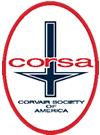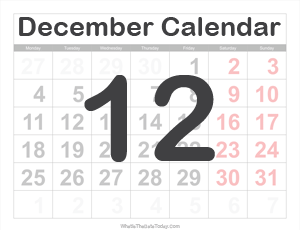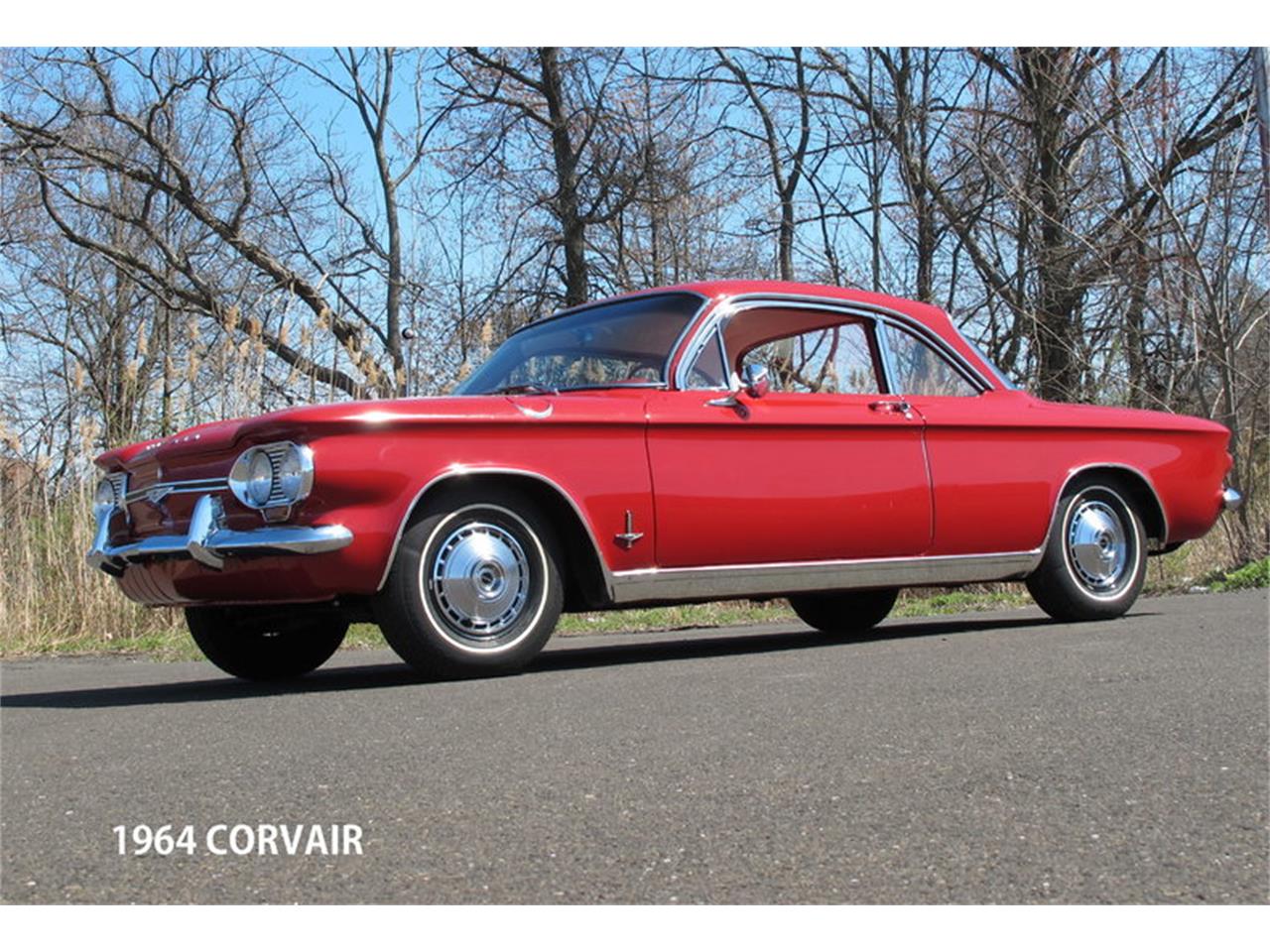Hey all! My name is Erik, and I just picked up a 2dr 4spd 64 Monza In the beginning of July. I have loved Corvairs and loved classics since I was a kid but never had the means or the know how. But I just picked this one up after the wife and I moved out of our apartment and now have a garage and driveway. I know almost nothing about working on cars but have always wanted to learn. Figured, why not just start now. I am in San Jose, California and I am a barber around 30 years old. I would love all the help I can get for sure.
The car looks great on the exterior and has most thing original. It runs, which is nice, but has some clicking sounds and it doesn't idle very well. From my research on this forum, youtube, and other online searches, I think there is something wrong with the choke and fast idle. It doesn't idle great and one of the levers on the left carburetors a bit too loose.. either way, ill get some pictures and maybe a video or two of the car and share them.
looking forward to jumping in!
New Member San Jose, CA - New to cars
New Member San Jose, CA - New to cars
Last edited by Red64 on Tue Aug 11, 2020 2:40 pm, edited 2 times in total.
Re: New 64 Corvair, New to classics
Here's a link to the clicking/ticking noise it makes. Not sure what it is but I know its not supposed to.
https://www.youtube.com/watch?v=A2-3s1b ... b_err_woyt





https://www.youtube.com/watch?v=A2-3s1b ... b_err_woyt
Last edited by Red64 on Tue Aug 11, 2020 6:41 pm, edited 1 time in total.
- bbodie52
- Corvair of the Month

- Posts: 11908
- Joined: Mon Aug 06, 2012 12:33 pm
- Location: Lake Chatuge Hayesville, NC
- Contact:
Re: New Member San Jose, CA - New to cars
I have also loved Corvairs since I was a kid (8 years old) living on Fairhill Lane in San Jose (near Curtner Ave and Meridian Ave). My parents had purchased a brand new 1961 Corvair Monza 4-speed coupe (white with red interior). A few years later my parents upgraded their 1961 Corvair to a new 1965 Corvair Corsa convertible (140 hp).

We lived in San Jose and Campbell from 1959 until December 1969, and then relocated to Thousand Oaks, California when my father was transferred from Lockheed, Sunnyvale to Lockheed, Burbank. But before we moved I learned to overhaul my first Corvair engine and Powerglide transmission in our Campbell garage during my high school summer vacation at age 16. While Neil Armstrong was walking on the moon, I was learning to remove a Corvair powertrain from a 1963 Corvair 500. My father was already in Southern California, so I was on my own — no Internet, no Corvair Society of America (CORSA), no Corvair Forum — but... I could still buy Corvair parts at the Courtesy Chevrolet Parts Department! A few years later that engine rebuild powered a 1962 Monza coupe that I drove in 1972 to/from my wedding and on our honeymoon!

My point that I am getting at is that with tools, a garage, and a Corvair shop manual, support from the local CORSA club chapter in San Jose (and perhaps others in the Bay Area), and with Internet support from web sites like this Corvair Forum, you can successfully learn to be a DIY mechanic and tackle many jobs on your "new" 1964 Corvair Monza.

Silicon Valley CORSA San Jose
Silicon Valley Corsa, Seth Emerson, President, 3462 Kirkwood Dr., San Jose, CA 95117, https://www.perfvair.com/Description: A chapter of the national organization open to everyone interested in the Corvair automobile. Meetings involve technical discussions, repair help, parts sales and concours and activity planning. Meetings are held the third Tuesday of every month (except October) at Wilcox High School, 3250 Monroe Street, Santa Clara, from 7:30 pm- 9:30 pm.
P.O. Box 2792
Santa Clara, CA 95055-2792
Phone: (408) 247-2237
eMail: sethracer@aol.com or silicon_valley@corvair.org
 San Francisco Bay Area CORSA Walnut Creek
San Francisco Bay Area CORSA Walnut Creek 
Mels Vairmart
1443 Laurelwood Rd, Santa Clara, CA 95054
Phone: (408) 267-8164
The link below will provide you with a list of useful websites that are Corvair-related. Some of the links will lead you to an extensive technical library that will allow you to download shop manuals and other technical references in Adobe Reader format at no cost. There is also a link that will help you to locate nearby CORSA (Corvair Society of America) club chapters. You will also find a list of essential Corvair parts suppliers. Clark's Corvair Parts in Shelburne Falls, MA is the biggest and oldest Corvair supplier in the world. You will find a link that can provide you with a series of videos that amount to a tour of the Clark's Corvair Parts facilities. Parts suppliers such as this truly make our Corvair hobby possible.
Common and Useful Corvair Websites
Corvair Forum
With regard to that ticking noise, you might try temporarily removing the fan belt and then run the engine for a few seconds to see if the ticking sound is still present without the belt in-place. If the sound goes away without the belt, try rotating the blower by hand, and the idler pulley by hand with the belt off, and with the engine off. See if you detect any roughness or noise in either bearing. Also rotate the generator by hand to look for a noise source there. Using an inexpensive mechanic's stethoscope with the belt in-place may also help you to isolate the noise source.
Brad Bodie
Lake Chatuge, North Carolina
 1966 Corvair Corsa Convertible
1966 Corvair Corsa Convertible
Lake Chatuge, North Carolina
 1966 Corvair Corsa Convertible
1966 Corvair Corsa Convertible- bbodie52
- Corvair of the Month

- Posts: 11908
- Joined: Mon Aug 06, 2012 12:33 pm
- Location: Lake Chatuge Hayesville, NC
- Contact:
Re: New Member San Jose, CA - New to cars

I will decode the body tag for you...bbodie52 wrote:Classic cars had a different way of doing things in the 1950s, 1960s and earlier, when compared to modern techniques utilizing sensors and computer technology to control fuel injection and ignition systems. There was a series of books that were published in the 1960s and 1970s that focus on basic principles of automobile design and function. These books covered basics associated with carburetors, ignition systems, suspension and brake systems, etc. When I was a teenager I read through many of these books and they gave me a good understanding of the principles and functional designs that were common in the cars that I was interested in, including the Corvair. Once I read through these books, the shop manuals made a lot more sense to me as I began to understand how things function and what I was trying to accomplish in working on my Corvair. This series was published long ago (1960s-1970s) by Petersen Publishing Company, which was also associated with Hot Rod Magazine. With titles like Petersen's Basic Cams, Valves and Exhaust Systems, Petersen's Basic Ignition and Electrical Systems, and Petersen's Basic Carburetion and Fuel Systems, I was a teenager that found myself devouring much of the series to teach myself the basics that could be applied to most 1970s and earlier vehicles. The material in those books are now somewhat dated because of the change to computer-controlled electronic fuel injection and other sophisticated technologies that have been introduced in the subsequent decades. But I do feel a Corvair owner or any classic car owner could benefit from the material in these books. Many of them are listed as available on Amazon.com. If you would like to consider the possibility of reading through some of this material, the following link may help you to find what you're looking for. The cost of these books is low, and the investment in time that you might make in reading them may help you to develop a foundation of knowledge that will help you to leap ahead in your DIY maintenance efforts on your Corvair.
https://www.amazon.com/s/ref=nb_sb_noss ... pany+basic
ebayhttps://www.ebay.com/sch/i.html?_odkw=b ... c&_sacat=0
Here is a breakdown of the information on the body tag you provided...
BODY TAG INFO:
12A
Body Build Date: 12 = December (1963), A = First Week
The first digits are numbers 1 through 12, indicating the month of manufacture. The letter is A-E, indicate the week of the month. If the letter is a "A" it indicates the first week of the month.

STYLE 64 0927 BODY WR 29388
64 = 1964
Model 0927 — 2-Door Monza Club Coupe — 4 Passenger, 09 = 900 Series Monza, 27 = 2-Door Club Coupe,
WR = Willow Run, Michigan Production Plant, Production Sequence No: 29388
1964 Corvair Monza 2-Door Coupe — 4 Passenger, Total Production: 88,440.
TRIM 781
781 = RED (Monza with Bucket Seats)
This 3 digit codes represents the interior paint and upholstery color and seat type.
BODY PAINT 922
922 = MEDIUM RED "Ember Red"

Lucite No. 4387LH, Rinshed-Mason No. A1538R, Ditzler No. DDL71336

1964 Corvair Monza Coupe Example (In Ember Red)
E 2LP 3C 5V
1964 Fisher Body Tag ACC line. (WR only)
The Letters are listed in groups. Letters following a number is in that group. The code letters are listed in the order they would appear. Some letters are in more than one group
Tag style change at either 10C or 10D
First Group (no numeric indicator)
D = (RPO C06) Power top
E = (RPO A01) Tinted windshield and side glass
W = (RPO A02) Tinted windshield only
2 = Second Group
E = (RPO C60) Air Conditioning
L = (RPO M20) 4 Speed Manual Transmission
M = (RPO M35) 2 Speed Powerglide Automatic Transmission
P = (RPO Z01) Convenience group (2 speed wipers, w/washer, day/night mirror, glovebox light, backup lights)
R = (RPO Z02) Rear speaker
S = (Order Code 44) Rear antenna (single or dual)
3 = Third Group
C = (RPO B70) Padded dashboard
4 = Fourth Group
F= (RPO Z13) Convenience group (2 speed wipers, w/washer, day/night mirror, glovebox light, backup lights, remote outside mirror)
5 = Fifth Group
O = (RPO A62) Seatbelt delete (after Jan 1, 1964)
V = (RPO A37) Custom deluxe front seat belts, no retractors (before Jan 31, 1964)
W = (RPO A49) Custom Deluxe seat belts, with retractors (after early November, 1963)
D (Interior Paint Code): 1964: A= Aqua B= Blue C= Saddle D= Red E= Black F= Fawn Q= White/Red
========================================================================
The VIN tag is located in the left door jamb.
40927Wnnnnnn
I have attached a copy of the 1964 GM Heritage Center Specifications
- Attachments
-
- 1964 Chevrolet Corvair GM Heritage Center Specs.pdf
- 1964 Chevrolet Corvair GM Heritage Center Specs
- (2.57 MiB) Downloaded 6 times
Brad Bodie
Lake Chatuge, North Carolina
 1966 Corvair Corsa Convertible
1966 Corvair Corsa Convertible
Lake Chatuge, North Carolina
 1966 Corvair Corsa Convertible
1966 Corvair Corsa Convertible



